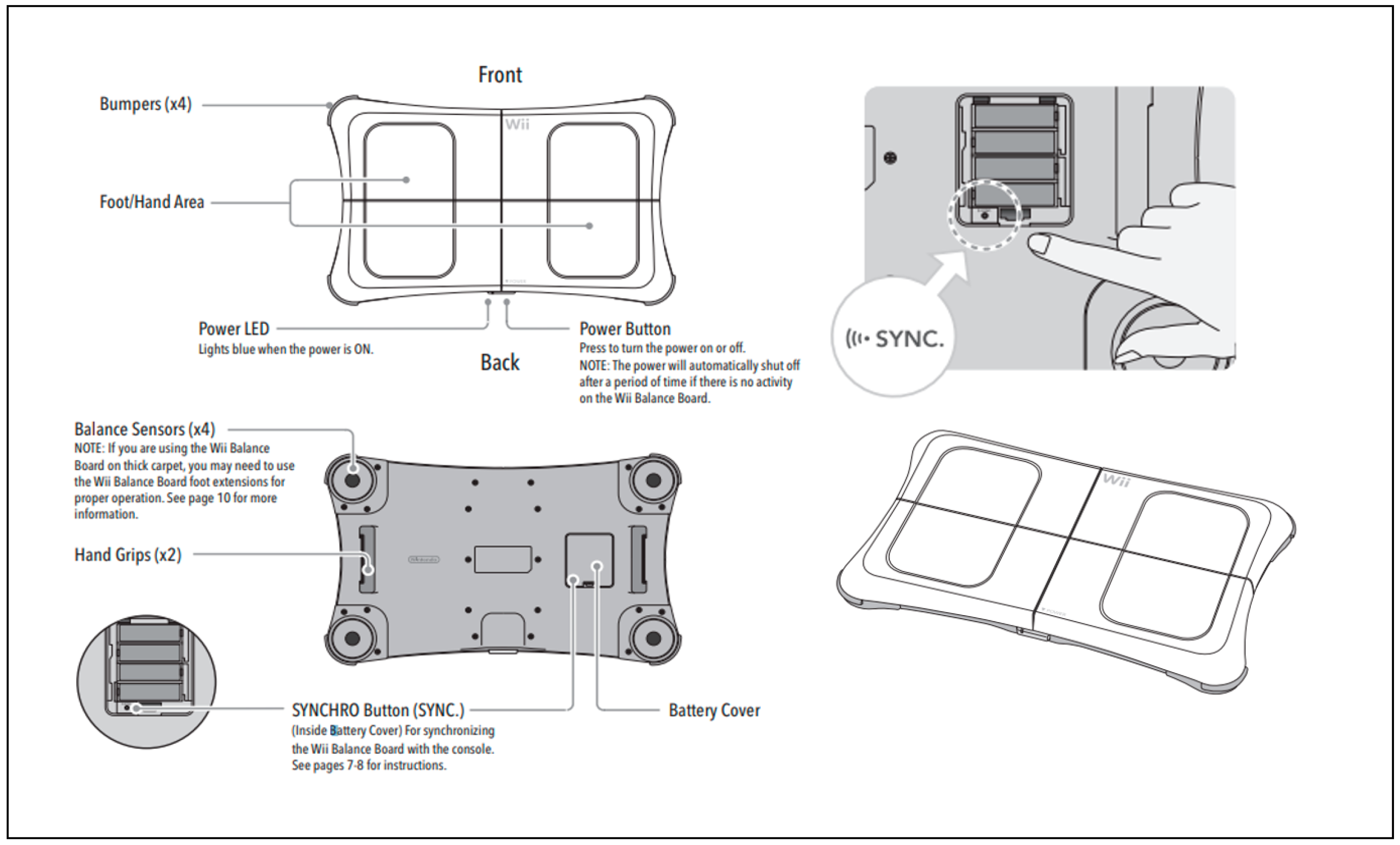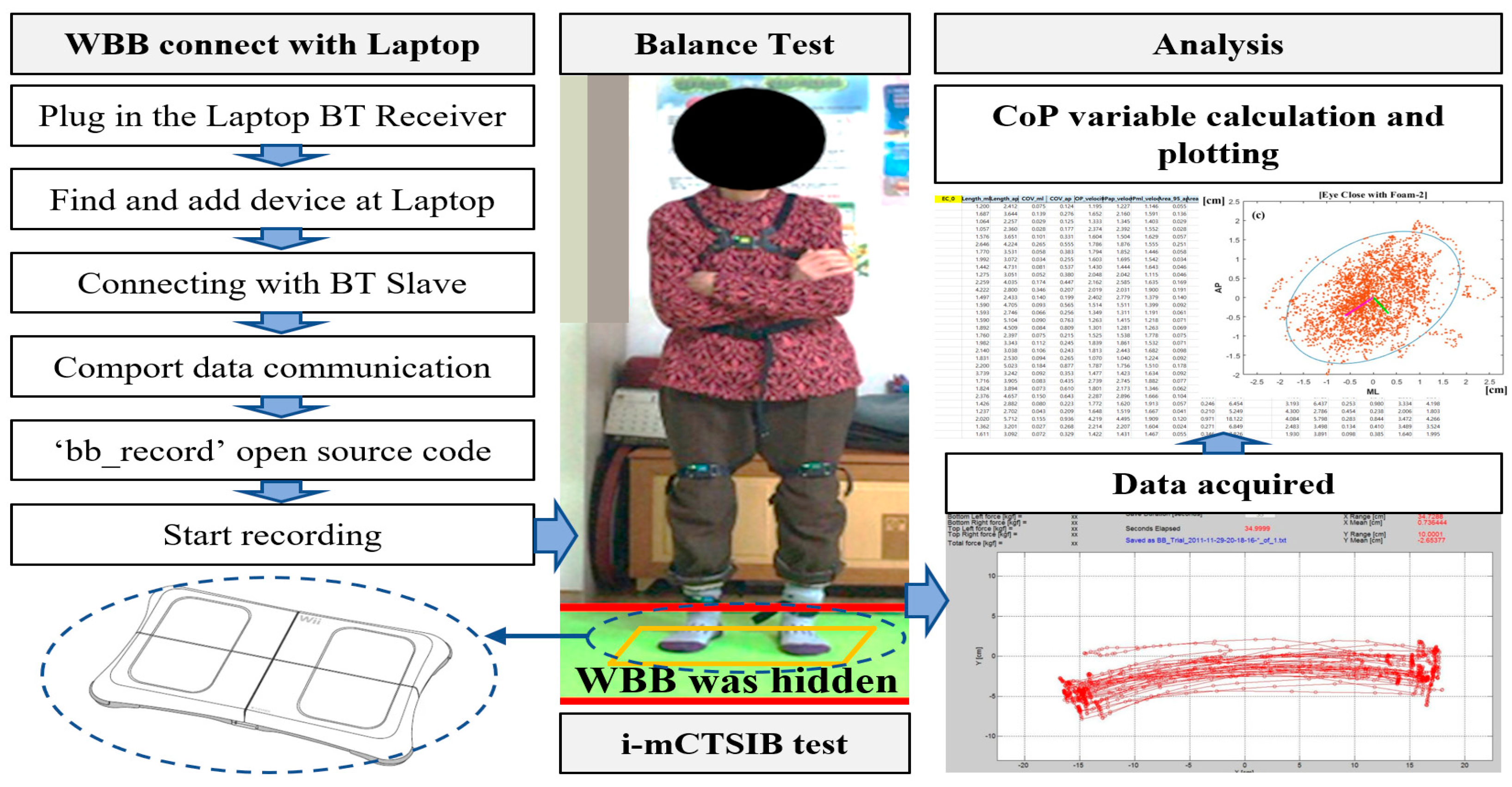Sensory Interaction and Balancing Ability Evaluation of the Elderly Using a Simplified Force Plate System
Abstract
:1. Introduction
2. Materials and Methods
2.1. Data Acquisition System Configuration
2.2. Participants
2.3. Experimental Protocol
2.4. Data Analysis
3. Results
4. Discussion
5. Conclusions
Author Contributions
Funding
Institutional Review Board Statement
Informed Consent Statement
Data Availability Statement
Conflicts of Interest
References
- Pollock, A.S.; Durward, B.R.; Rowe, P.J.; Paul, J.P. What is balance? Clin. Rehabil. 2000, 14, 402–406. [Google Scholar] [CrossRef] [PubMed]
- Era, P.; Heikkinen, E.; Gause-Nilsson, I.; Schroll, M. Postural balance in elderly people: Changes over a five-year follow-up and its predictive value for survival. Aging Clin. Exp. Res. 2002, 14, 37–46. [Google Scholar] [PubMed]
- Steindl, R.; Kunz, K.; Schrott-Fischer, A.; Scholtz, A.W. Effect of age and sex on maturation of sensory systems and balance control. Dev. Med. Child. Neurol. 2006, 48, 477–482. [Google Scholar] [CrossRef] [PubMed]
- Peterka, R.J. Sensorimotor integration in human postural control. J. Neurophysiol. 2002, 88, 1097–1118. [Google Scholar] [CrossRef] [PubMed] [Green Version]
- Wu, P.; Cao, W.; Hu, Y.; Li, H. Effects of vestibular rehabilitation, with or without betahistine, on managing residual dizziness after successful repositioning manoeuvres in patients with benign paroxysmal positional vertigo: A protocol for a randomised controlled trial. BMJ Open 2019, 18, 026711. [Google Scholar] [CrossRef] [PubMed]
- Alahmari, K.A.; Marchetti, G.F.; Sparto, P.J.; Furman, J.M.; Whitney, S.L. Estimating postural control with the balance rehabilitation unit: Measurement consistency, accuracy, validity, and comparison with dynamic posturography. Arch. Phys. Med. Rehabil. 2014, 95, 65–73. [Google Scholar] [CrossRef] [PubMed] [Green Version]
- Abate, M.; Di Iorio, A.; Pini, B.; Battaglini, C.; Di Nicola, I.; Foschini, N.; Guglielmi, M.; Marinelli, M.; Tocco, P.; Saggini, R.; et al. Effects of hypertension on balance assessed by computerized posturography in the elderly. Arch. Gerontol. Geriatr. 2009, 49, 113–117. [Google Scholar] [CrossRef] [PubMed]
- Smalley, A.; White, S.C.; Burkard, R. The effect of augmented somatosensory feedback on standing postural sway. Gait Posture 2018, 60, 76–80. [Google Scholar] [CrossRef] [PubMed]
- Lee, C.H.; Sun, T.L. Evaluation of postural stability based on a force plate and inertial sensor during static balance measurements. J. Physiol. Anthropol. 2018, 37, 27. [Google Scholar] [CrossRef] [PubMed] [Green Version]
- Degani, A.M.; Leonard, C.T.; Danna-Dos-Santos, A. The effects of early stages of aging on postural sway: A multiple domain balance assessment using a force platform. J. Biomech. 2017, 64, 8–15. [Google Scholar] [CrossRef] [PubMed]
- Caballero, C.; Barbado, D.; Moreno, F.J. What COP and kinematic parameters better characterize postural control in standing balance tasks? J. Mot. Behav. 2015, 47, 550–562. [Google Scholar] [CrossRef] [PubMed]
- Clark, R.A.; Mentiplay, B.F.; Pua, Y.H.; Bower, K.J. Reliability and validity of the Wii Balance Board for assessment of standing balance: A systematic review. Gait Posture 2018, 61, 40–54. [Google Scholar] [CrossRef] [PubMed]
- BME Design of University of Wisconsin-Madison—Biomedical Engineering Department. Available online: https://bmedesign.engr.wisc.edu/projects/f11/balance_trainer/file/view/c3bea4e1-e005-4c5e-ae27-ebc892a30e17/WBB_Final_Paper.pdf (accessed on 1 October 2018).
- Godi, M.; Franchignoni, F.; Caligari, M.; Giordano, A.; Turcato, A.M.; Nardone, A. Comparison of reliability, validity, and responsiveness of the MiniBESTest and Berg Balance Scale in patients with balance disorders. Phys. Ther. 2013, 93, 158–167. [Google Scholar] [CrossRef] [PubMed] [Green Version]
- Severini, G.; Straudi, S.; Pavarelli, C.; Da Roit, M.; Martinuzzi, C.; Pizzongolo, L.D.; Basaglia, N. Use of Nintendo Wii Balance Board for posturographic analysis of Multiple Sclerosis patients with minimal balance impairment. J. Neuroeng. Rehabil. 2017, 11, 19. [Google Scholar] [CrossRef] [PubMed] [Green Version]
- Chaikeeree, N.; Saengsirisuwan, V.; Chinsongkram, B.; Boonsinsukh, R. Interaction of age and foam types used in Clinical Test for Sensory Interaction and Balance (CTSIB). Gait Posture 2015, 41, 313–315. [Google Scholar] [CrossRef] [PubMed]
- D’Anna, C.; Gazzellini, S.; Petrarca, M.; Vasco, G.; Castelli, E.; Schmid, M.; Conforto, S. Time to boundary function to assess upright stance in blind children. Annu. Int. Conf. IEEE Eng. Med. Biol. Soc. 2015, 2015, 3468–3471. [Google Scholar] [CrossRef]
- Moran, R.N.; Cochrane, G. Preliminary study on an added vestibular-ocular reflex visual conflict task for postural control. J. Clin. Transl. Res. 2020, 26, 155–160. [Google Scholar]
- Tjernström, F.; Björklund, M.; Malmström, E.M. Romberg ratio in quiet stance posturography—Test to retest reliability. Gait Posture 2015, 42, 27–31. [Google Scholar] [CrossRef] [PubMed] [Green Version]
- Truszczyńska, A.; Drzał-Grabiec, J.; Trzaskoma, Z.; Rąpała, K.; Tarnowski, A.; Górniak, K. A comparative analysis of static balance between patients with lumbar spinal canal stenosis and asymptomatic participants. J. Manip. Physiol. Ther. 2014, 37, 696–701. [Google Scholar] [CrossRef] [PubMed]
- Glowinski, S.; Ptak, M. A kinematic model of a humanoid lower limb exoskeleton with pneumatic actuators. Acta Bioeng. Biomech. 2022, 24, 145–157. [Google Scholar] [CrossRef]



| Variable | Subjects | ||
|---|---|---|---|
| Female | Male | p-Value | |
| No. | 60 | 24 | - |
| Age (years) | 77.37 ± 4.99 | 79.83 ± 4.73 | * 0.04 |
| Height (cm) | 149.57 ± 4.52 | 164.88 ± 6.29 | * 0.00 |
| Weight (kg) | 56.07 ± 7.46 | 68.68 ± 10.22 | * 0.00 |
| Berg Balance Scale (score) | 53.05 ± 1.83 | 53.08 ± 2.73 | 0.95 |
| K-MMSE (score) | 17.99 ± 3.47 | 22.66 ± 2.74 | * 0.00 |
| Variables | Firm-Eye Open | Foam1-Eye Open | Foam2-Eye Open |
|---|---|---|---|
| CoP Range ML [cm] | 2.14 ± 1.13 *# | 2.83 ± 1.12 *$ | 4.29 ± 1.78 #$ |
| CoP Range AP [cm] | 3.28 ± 0.94 * | 3.50 ± 0.93 | 3.72 ± 1.11 * |
| CoP Covariance ML [cm] | 0.14 ± 0.16 *# | 0.29 ± 0.31 *$ | 0.54 ± 0.38 #$ |
| CoP Covariance AP [cm] | 0.35 ± 0.21 | 0.36 ± 0.17 | 0.38 ± 0.26 |
| CoP Velocity ML [cm/s] | 1.46 ± 0.33 *# | 1.79 ± 0.39 *$ | 2.14 ± 0.45 #$ |
| CoP Velocity AP [cm/s] | 1.47 ± 0.38 *# | 1.84 ± 0.47 *$ | 2.14 ± 0.57 #$ |
| CoP Velocity RMS [cm/s] | 1.46 ± 0.23 *# | 1.76 ± 0.31 *$ | 2.18 ± 0.40 #$ |
| 95% COV of Eigenvalue AP [cm] | 0.11 ± 0.10 *# | 0.18 ± 0.11 *$ | 0.28 ± 0.13 #$ |
| 95% COV of Eigenvalue ML [cm] | 0.38 ± 0.23 *# | 0.47 ± 0.31 *$ | 0.64 ± 0.43 #$ |
| 95% Ellipse sway area [cm2] | 11.65 ± 8.56 *# | 16.15 ± 9.81 *$ | 26.18 ± 16.29 #$ |
| Variables | Firm-Eye Close | Foam1-Eye Close | Foam2-Eye Close |
|---|---|---|---|
| CoP Range ML [cm] | 1.97 ± 0.88 *# | 2.96 ± 1.36 *$ | 4.98 ± 2.01 #$ |
| CoP Range AP [cm] | 3.54 ± 1.19 *# | 4.04 ± 1.02 *$ | 4.71 ± 1.49 #$ |
| CoP Covariance ML [cm] | 0.13 ± 0.15 *# | 0.26 ± 0.18 *$ | 0.77 ± 0.58 #$ |
| CoP Covariance AP [cm] | 0.41 ± 0.29 *# | 0.50 ± 0.26 *$ | 0.64 ± 0.38 #$ |
| CoP Velocity ML [cm/s] | 1.77 ± 0.51 *# | 2.21 ± 0.62 *$ | 2.69 ± 0.71 #$ |
| CoP Velocity AP [cm/s] | 1.92 ± 0.69 *# | 2.52 ± 0.86 *$ | 2.91 ± 0.90 #$ |
| CoP Velocity RMS [cm/s] | 1.52 ± 0.23 *# | 1.83 ± 0.35 *$ | 2.50 ± 0.62 #$ |
| 95% COV of Eigenvalue AP [cm] | 0.10 ± 0.09 *# | 0.20 ± 0.14 *$ | 0.45 ± 0.28 #$ |
| 95% COV of Eigenvalue ML [cm] | 0.44 ± 0.31 *# | 0.56 ± 0.27 *$ | 0.96 ± 0.60 #$ |
| 95% Ellipse sway area [cm2] | 11.58 ± 7.67 *# | 19.60 ± 12.04 *$ | 38.71 ± 23.04 #$ |
| Modified Romberg Ratio | Firm | Foam-1 | Foam-2 |
|---|---|---|---|
| CoP Range ML [cm] | −4.22 | 2.35 | 7.51 |
| CoP Range AP [cm] | 3.89 | 7.20 | 11.76 |
| CoP Covariance ML [cm] | −4.67 | −5.09 | 17.43 |
| CoP Covariance AP [cm] | 7.89 | 17.12 | 24.92 |
| CoP Velocity ML [cm/s] | 9.66 | 10.42 | 11.35 |
| CoP Velocity AP [cm/s] | 13.32 | 15.42 | 15.25 |
| CoP Velocity RMS [cm/s] | 2.33 | 2.11 | 6.95 |
| 95% COV of Eigenvalue AP [cm] | −5.29 | 7.06 | 22.71 |
| 95% COV of Eigenvalue ML [cm] | 7.18 | 8.85 | 19.82 |
| 95% Ellipse sway area [cm2] | −0.29 | 9.64 | 19.32 |
| Firm | Foam-1 | Foam-2 | ||||
|---|---|---|---|---|---|---|
| Variables | Eye Close | Eye Open | Eye Close | Eye Open | Eye Close | Eye Open |
| CoP Range ML [cm] | 0.01 | −0.04 | −0.09 | −0.02 | −0.14 | 0.01 |
| CoP Range AP [cm] | 0.02 | −0.21 | −0.33 | −0.16 | −0.15 | −0.10 |
| CoP Covariance ML [cm] | −0.03 | −0.12 | −0.13 | −0.12 | −0.17 | −0.20 |
| CoP Covariance AP [cm] | 0.07 | −0.15 | −0.25 | −0.05 | −0.13 | −0.13 |
| CoP Velocity ML [cm/s] | −0.06 | 0.06 | −0.15 | −0.07 | −0.06 | −0.03 |
| CoP Velocity AP [cm/s] | 0.01 | −0.08 | −0.20 | −0.06 | −0.11 | −0.11 |
| CoP Velocity RMS [cm/s] | 0.11 | 0.05 | 0.04 | 0.06 | 0.03 | −0.08 |
| 95% COV of Eigenvalue AP [cm] | −0.07 | −0.08 | −0.16 | −0.10 | −0.14 | −0.12 |
| 95% COV of Eigenvalue ML [cm] | 0.06 | −0.18 | −0.21 * | −0.09 | −0.19 | −0.21 * |
| 95% Ellipse sway area [cm2] | 0.01 | −0.10 | −0.21 * | −0.08 | −0.19 | −0.02 |
Publisher’s Note: MDPI stays neutral with regard to jurisdictional claims in published maps and institutional affiliations. |
© 2022 by the authors. Licensee MDPI, Basel, Switzerland. This article is an open access article distributed under the terms and conditions of the Creative Commons Attribution (CC BY) license (https://creativecommons.org/licenses/by/4.0/).
Share and Cite
Seo, J.-W.; Kim, J.I.; Kim, T.; Jang, K.-M.; Jeong, Y.; Do, J.-H. Sensory Interaction and Balancing Ability Evaluation of the Elderly Using a Simplified Force Plate System. Sensors 2022, 22, 8883. https://doi.org/10.3390/s22228883
Seo J-W, Kim JI, Kim T, Jang K-M, Jeong Y, Do J-H. Sensory Interaction and Balancing Ability Evaluation of the Elderly Using a Simplified Force Plate System. Sensors. 2022; 22(22):8883. https://doi.org/10.3390/s22228883
Chicago/Turabian StyleSeo, Jeong-Woo, Joong Il Kim, Taehong Kim, Kyoung-Mi Jang, Youngjae Jeong, and Jun-Hyeong Do. 2022. "Sensory Interaction and Balancing Ability Evaluation of the Elderly Using a Simplified Force Plate System" Sensors 22, no. 22: 8883. https://doi.org/10.3390/s22228883
APA StyleSeo, J.-W., Kim, J. I., Kim, T., Jang, K.-M., Jeong, Y., & Do, J.-H. (2022). Sensory Interaction and Balancing Ability Evaluation of the Elderly Using a Simplified Force Plate System. Sensors, 22(22), 8883. https://doi.org/10.3390/s22228883







